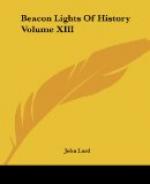Nine years before the appearance of the 1842 volume of Tennyson’s verse the poet’s bosom friend, Arthur Hallam, died at an immature age at Vienna, and his death was the subject of much brooding in noble, elegiac verse, written, as was Milton’s ‘Lycidas,’ to commemorate the loss of one very dear to the poet. In “In Memoriam,” as all know, Tennyson sought to assuage his grief and give fine, artistic expression to his profound sorrow at the loss of his companion and friend; but the work is more than a labored monument of woe, since it enshrines reflections of the most exalted and inspiring character on the eternally momentous themes of life, death, and immortality. The work was published in 1850, and it at once challenged the admiration of the world for the perfection of its art, no less than for its high contemplative beauty. This was the year when Wordsworth passed to the grave, and Tennyson, in his room, was given the English laureateship. In this year, also, we find him happily married to Emily S. Sellwood, a lady of Berks, to whom the poet had been engaged since 1837. With his bride he took up house at Twickenham, near London, where his son, Hallam Tennyson, was born in 1852. In the following year he removed to Farringford, on the Isle of Wight, which was to be his home for forty years, and where, as his son tells us, some of his best-known works were written. Here, in 1854, his second son, Lionel, was born, whose young life of promise was terminated by jungle fever thirty-two years later on a return voyage from India,—all that was mortal of him finding repose in the depths of the Red Sea. To complete the chief incidents in the poet’s personal career, we may here record that while Tennyson acquired another home at Aldworth, Surrey,—where he died Oct. 6, 1892, followed some four years later by his wife,—his happiest days were spent at Farringford, the pilgrimage




